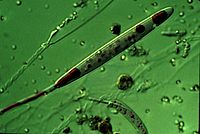
Photo from wikipedia
The efficiency of Cu(In,Ga)(S,Se)2 (CIGSSe) solar cell absorbers can be increased by the optimization of the Ga/In and S/Se gradients throughout the absorber. Analyzing such gradients is therefore an important… Click to show full abstract
The efficiency of Cu(In,Ga)(S,Se)2 (CIGSSe) solar cell absorbers can be increased by the optimization of the Ga/In and S/Se gradients throughout the absorber. Analyzing such gradients is therefore an important method in tracking the effectiveness of process variations. To measure compositional gradients in CIGSSe, energy dispersive X-ray analysis (EDX) with different acceleration energies performed at both the front surface and the backside of delaminated absorbers was used. This procedure allows for the determination of compositional gradients at locations that are millimeters apart and distributed over the entire sample. The method is therefore representative for a large area and yields information about the lateral homogeneity in the millimeter range. The procedure is helpful if methods such as secondary ion-mass (SIMS), time-of-flight SIMS, or glow-discharge optical emission spectrometry (GDOES) are not available. Results of such EDX measurements are compared with GDOES, and they show good agreement. The procedure can also be used in a targeted manner to detect local changes of the gradients in inhomogeneities or points of interest in the µm range. As an example, a comparison between the compositional gradients in the regular absorber and above the laser cut separating the Mo back contact is shown.
Journal Title: Materials
Year Published: 2021
Link to full text (if available)
Share on Social Media: Sign Up to like & get
recommendations!